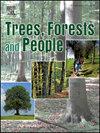Local knowledge on population structure and conservation of Lannea species in Burkina Faso (West Africa)
IF 2.7
Q1 FORESTRY
引用次数: 0
Abstract
Fruit trees occupy an important place in the daily life of people in West Africa, but the most valuable species are often overexploited and undergo severe threats. This study focused on three Lannea species (Lannea macrocarpa, Lannea acida, and Lannea velutina) with the aim to assess local ecological knowledge on habitats, population dynamics, drivers of degradation and conservation strategies. Data were collected through semi-structured interviews with 576 informants in 16 localities across the Sudanian and the Sudano-Sahelian climatic zones of Burkina Faso. The majority of respondents (86 %) recognize, reduced rainfall is as the primary driver of Lannea velutina population declines in the Sudano-Sahelian zone. In the Sudanian zone, however, more respondents (75 %) identified bushfires as the main threat to Lannea microcarpa and Lannea acida populations. These changes were more reported by women (63 %) than men (55 %), and the Mossi ethnic group exhibited a particularly detailed knowledge of Lannea population dynamics in the Sudano-Sahelian zone. Conservation efforts are largely supported by traditional cultural practices, with cultural bans for the three Lannea species. Assisted natural regeneration is also practiced for Lannea acida and Lannea microcarpa. The findings revealed significant variations in local perceptions of habitat changes and conservation strategies across climate zones, species, and ethnic groups (p< 0.05), but also stress the potential of building on traditional practices in nature management and conservation.
布基纳法索(西非)Lannea物种种群结构及保护的地方性知识
在西非,果树在人们的日常生活中占有重要地位,但最宝贵的树种往往被过度开发,并受到严重威胁。本研究以三种Lannea (Lannea macrocarpa)、Lannea acida和Lannea velutina为研究对象,探讨了当地对Lannea生境、种群动态、退化驱动因素和保护策略的认识。通过对苏丹和布基纳法索苏丹-萨赫勒气候带16个地点的576名线人进行半结构化访谈收集数据。大多数受访者(86%)认识到,降雨量减少是苏丹-萨赫勒地区绒毡兰种群减少的主要原因。然而,在苏丹地区,更多的回答者(75%)认为森林大火是对小叶杉和酸叶杉种群的主要威胁。女性(63%)比男性(55%)报告的这些变化更多,而且莫西族对苏丹-萨赫勒地区的兰尼亚人口动态表现出特别详细的了解。保护工作在很大程度上得到了传统文化习俗的支持,对三种Lannea物种实行了文化禁令。辅助自然再生也适用于酸绒棉和微绒棉。研究结果显示,不同气候带、不同物种和不同民族对栖息地变化和保护策略的看法存在显著差异(p<;0.05),但也强调了在自然管理和保护方面借鉴传统做法的潜力。
本文章由计算机程序翻译,如有差异,请以英文原文为准。
求助全文
约1分钟内获得全文
求助全文
来源期刊

Trees, Forests and People
Economics, Econometrics and Finance-Economics, Econometrics and Finance (miscellaneous)
CiteScore
4.30
自引率
7.40%
发文量
172
审稿时长
56 days
 求助内容:
求助内容: 应助结果提醒方式:
应助结果提醒方式:


